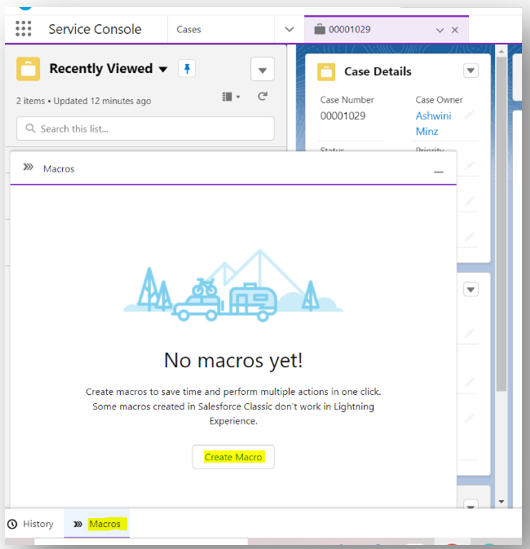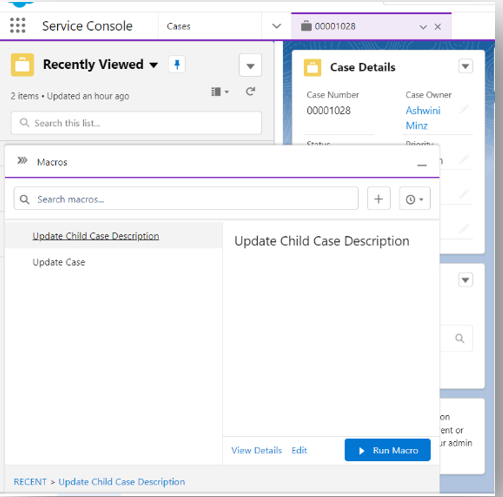How Salesforce Macros Can Boost Your Productivity and Improve Customer Experience?
Author
Macros in Salesforce is a set of predefined tasks. It is basically a powerful tool used to perform repetitive actions. Operations such as populating a text field, selecting an email template, sending an email, updating a case, logging a call, updating a field in a record, and many more can be implemented with the help of Macros. It prevents multiple manual clicks by providing the seamless single click feature for any task. Besides this, one can also decide the sequence of actions to be performed one after another in the order defined under the Macro.
Macros are present in the app’s utility bar. From there, the users can run and create Macros on the open record. If you try to access Macros in any page that does not support Macros, a message is displayed “This page doesn’t support macros”. For Example: Accessing Macros on Home tab.
Prerequisite for Salesforce Macros:
- Make sure that the record page includes a publisher such as log a call, Email, New child Case, etc.
- Make sure Macros is enabled in your org. This can be done by searching Macro Settings in the quick find box.
Types of Macros:
Regular Macros: These types of Macros perform tasks that are created but not saved or sent. Examples include inserting a predefined text in a text area field, only inserting the email template without sending, and more.
Irreversible Macros: As the name implies the action performed cannot be reversed. Examples include sending an email etc.
Bulk Macros: These kinds of Macros are supported for multiple records at a time
Add Macros to Utility Bar:
To add Macros in the utility bar for an app, Open the App from the app manager. Click on the dropdown menu to proceed to Edit. Now go to Utility Items and click Add Utility Item. Search for Macros and add. Save and now you will find the Macro added into the Utility bar.
Permission for Macros:
To view Macros, the users must have read the Permission on Macros object and to create Macro, the user must have create Permission on Macros object.
For Bulk Macros, that is to run Macros on multiple records, Users must have “Run Macros on Multiple Records” permission.
To create Irreversible macros, users must have “Manage Macros Users Can’t Undo” permission.
Macros Use Case:
Consider a scenario where the user has to input the same set of information for a child case description. The description is quite long in the form of questions and one-word answers. It would be good if there was a mechanism where the user needs to provide only the one-word answer instead of writing all the descriptive questions. Here is where the Regular macros come in handy.
Creating Macros: From the utility bar, click on Macros, and then Create Macro
Add the Macro name, optionally add a description and then select the object the Macro will be applied to
Adding Instructions:
To add new instructions, click on Edit Instruction. This will open the Macro builder in a new tab. Click on the plus icon that appears while hovering over the quick action tabs.
For our scenario, we are selecting the new child case action and selecting the description field to auto-populate with some text questions.
Save the Macro
Run Macros: To run a macro, open a case record, click on Macros in the utility bar, select the Macro which you would like to run, click on Run Macro.
Here we selected the Update Child Case Description macro, and then on clicking Run Macro the child case description field was populated as per the instruction added by us.
Benefits of Incorporating Macros:
Increased efficiency – Macros can automate repetitive tasks. This reduces their time consumed in doing manual actions, improving overall efficiency.
Reduced training time – Macros are easy to use and understand. It can also be accessed easily making it user-friendly.
Customization – Macros can be customized to meet the specific needs of each user. This makes them a flexible tool.
Pranshu Goyal, Director of Products at Mirekta, states: “We envision DSM to be used by every small to a medium-sized organization dealing with bad data and want to get rid of duplicates easily with no cost. We have faced issues dealing with duplicates in our organization. That inspired us to make a solution that is not only simple to use but can be used widely to make the organization’s data clean to make them more efficient and productive. We want DSM to be a solution for every organization looking for duplicate management capability better than the Salesforce out-of-the-box solution with no additional cost.”
Recent Posts
-
Salesforce 2025 Game-Changing Trends You Need to Know28 Jan 2025 Blog
-
Agentforce 2.0: Everything You Need to Know About the Latest Update22 Jan 2025 Blog
-
The Ultimate Guide to NetSuite Development: Tools and Techniques10 Jan 2025 Blog
-
How Salesforce Nonprofit Cloud Transforms Fundraising Strategies10 Jan 2025 Blog
-
The Impact of Salesforce Development Partners on Small and Medium Businesses08 Jan 2025 Blog
-
Key Questions to Ask When Hiring a NetSuite Development Partner08 Jan 2025 Blog
-
Salesforce Agentforce Demystified: Your Essential Guide08 Jan 2025 Blog
-
Salesforce and NetSuite Integration: Driving Business Efficiency with Precision06 Jan 2025 Blog
-
Everest Group has positioned Mirketa as an Aspirant in the report24 Dec 2024 Press Release
-
Salesforce Einstein20 Dec 2024 E-Book
-
Order to Cash Cycle with NetSuite20 Dec 2024 E-Book
-
Empower Your Marketing Strategy with Salesforce Marketing Cloud's Automation Studio Activities13 Dec 2024 Blog
-
Salesforce CPQ for Subscription-based Businesses10 Dec 2024 Blog
-
Unleashing the Magic of Einstein Prediction Builder10 Dec 2024 Blog
-
Customized Templates and Branding with Salesforce Experience Cloud10 Dec 2024 Blog
-
Unleashing the Power of Real- Time Reports and Dashboards in NPSP10 Dec 2024 Blog
-
Top 4 Salesforce Automation Tools in 202409 Dec 2024 Blog
-
Salesforce Service Cloud Implementation: The Ultimate Guide09 Dec 2024 Blog
-
Salesforce CRM Implementation Partner Enhancing Automation in Healthcare09 Dec 2024 Blog
-
Shorten Your Sales Cycle in 8 Steps: Salesforce CPQ Implementation Guide09 Dec 2024 Blog
-
Overcoming Top 5 Common Sales Challenges With Salesforce Revenue Cloud06 Dec 2024 Blog
-
Empowering Sales Teams with Einstein: 5 Proven Methods to Drive Sales Success05 Dec 2024 Blog
-
Mirketa Recognized by NetSuite as Summer 2024 Alliance Partner Spotlight Award Winner04 Dec 2024 Blog
-
Salesforce Agentforce: Revolutionizing AI with Autonomous Agents03 Dec 2024 Blog
-
How to send information from one Salesforce Org A to another Org B using Salesforce Integration?30 Nov 2024 Blog
-
Mastering the Salesforce Quote to Cash Process: A Complete Guide for Businesses - Copy28 Nov 2024 E-Book
-
Salesforce Education Cloud in Higher Education: Transforming University Operations and Student Experience14 Nov 2024 Blog
-
The Future of Healthcare: Transforming with Salesforce Health Cloud & Elixir EHR14 Nov 2024 Blog
-
Mastering the Salesforce Quote to Cash Process: A Complete Guide for Businesses13 Nov 2024 Webinar
-
Mastering the Salesforce Quote to Cash Process: A Complete Guide for Businesses30 Oct 2024 E-Book
-
Mastering the Salesforce Quote to Cash Process: A Complete Guide for Businesses28 Oct 2024 Blog
-
Integrating Amazon OpenSearch Service with Salesforce26 Oct 2024 Blog
-
Salesforce Support and Services: Why They Are a Must for Optimizing CRM Performance10 Oct 2024 Blog
-
Salesforce Admin Support: Unveiling the Backbone of CRM Success03 Oct 2024 Blog
-
Mastering Salesforce Financial Services Cloud: A Step-by-Step Implementation Guide03 Oct 2024 Blog
-
Recap Dreamforce 2024: Unleashing the Power of AI and Data with Mirketa27 Sep 2024 Blog
-
How Salesforce’s Agentforce Revolutionizes Manufacturing Operations26 Sep 2024 Blog
-
Top 5 Benefits and Use Cases of Implementing Salesforce Health Cloud for Healthcare Providers24 Sep 2024 Blog
-
A Beginner’s Guide to NPSP Basics13 Sep 2024 Blog
-
How to Avoid 9 Common Mistakes when Selecting a Salesforce Consulting Partner09 Sep 2024 Blog
-
Expert Guide to Salesforce Implementation in 202405 Sep 2024 Blog
-
Mirketa to present a webinar on Digital Transformation for Nonprofits'01 Sep 2024 Press Release
-
Salesforce Support Specifics: How to Get Assistance and Resolve Issues Swiftly28 Aug 2024 Blog
-
Mirketa Expands Its Presence in Non-Profit Space with Salesforce Nonprofit Cloud01 Aug 2024 Press Release
-
Top Reasons to Choose an ISV as Your Preferred Salesforce Partner19 Jul 2024 Blog
-
Empowering Component Development in Salesforce Lightning06 Jul 2024 Blog
-
How Salesforce Macros Can Boost Your Productivity and Improve Customer Experience?26 Jun 2024 Blog
-
The Relationship Between NPSP and Salesforce Standard Objects10 Jun 2024 Blog
-
Unlocking Business Insights with Salesforce Reports and Dashboard04 Jun 2024 Blog
-
Maximizing Alumni Engagement with Salesforce Communities and Marketing Automation03 Jun 2024 Blog
-
NPSP Package vs. Nonprofit Cloud: Understanding the Differences and Choosing the Right Solution30 May 2024 Blog
-
Unleashing Soft Credit and Marketing Gift in Nonprofit Cloud: A Revolutionary Approach to Fundraising27 May 2024 Blog
-
Best Practices for Donor Management in NPSP24 May 2024 Blog
-
Grant Management with NPSP22 May 2024 Blog
-
Leveraging NPSP Automation for Managing Constituents20 May 2024 Blog
-
Comprehensive Guide to CPQ Product Rules15 May 2024 Blog
-
Enhancing Customer Experience with Salesforce Experience Cloud14 May 2024 Blog
-
Best Practices for Salesforce Marketing Cloud Implementation10 May 2024 Blog
-
Mastering Inventory Management for MedTech with Salesforce Health Cloud09 May 2024 Blog
-
Mastering Inventory Management for MedTech with Salesforce Health Cloud08 May 2024 Blog
Categories
Featured by








Office Locations

11501 Dublin Blvd STE 200, Dublin, CA 94568, USA

B-4/5 First Floor, Sector- 63, Noida 201301, India




























































